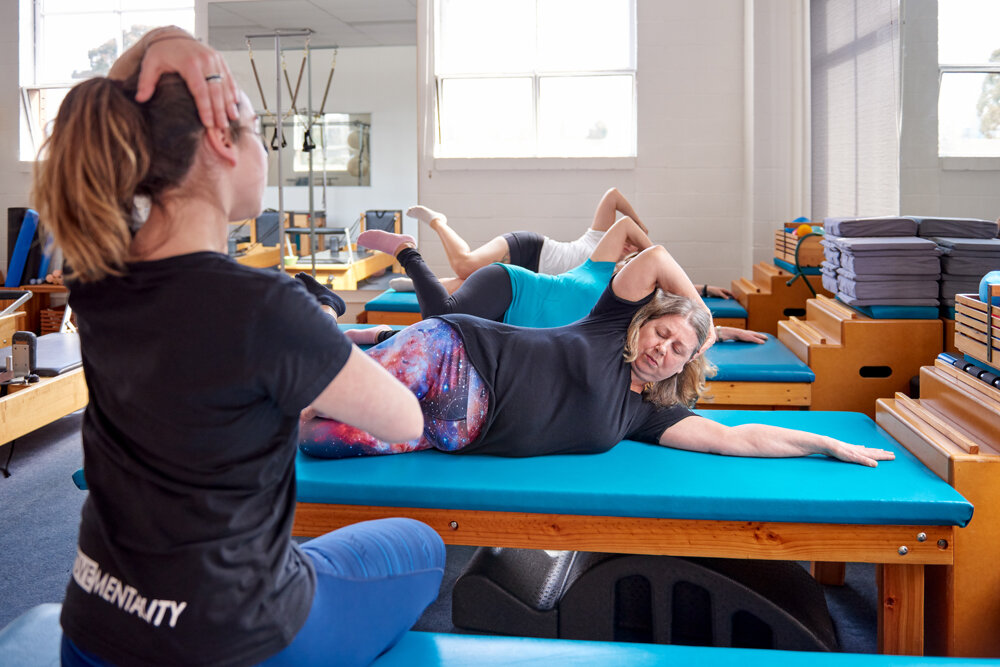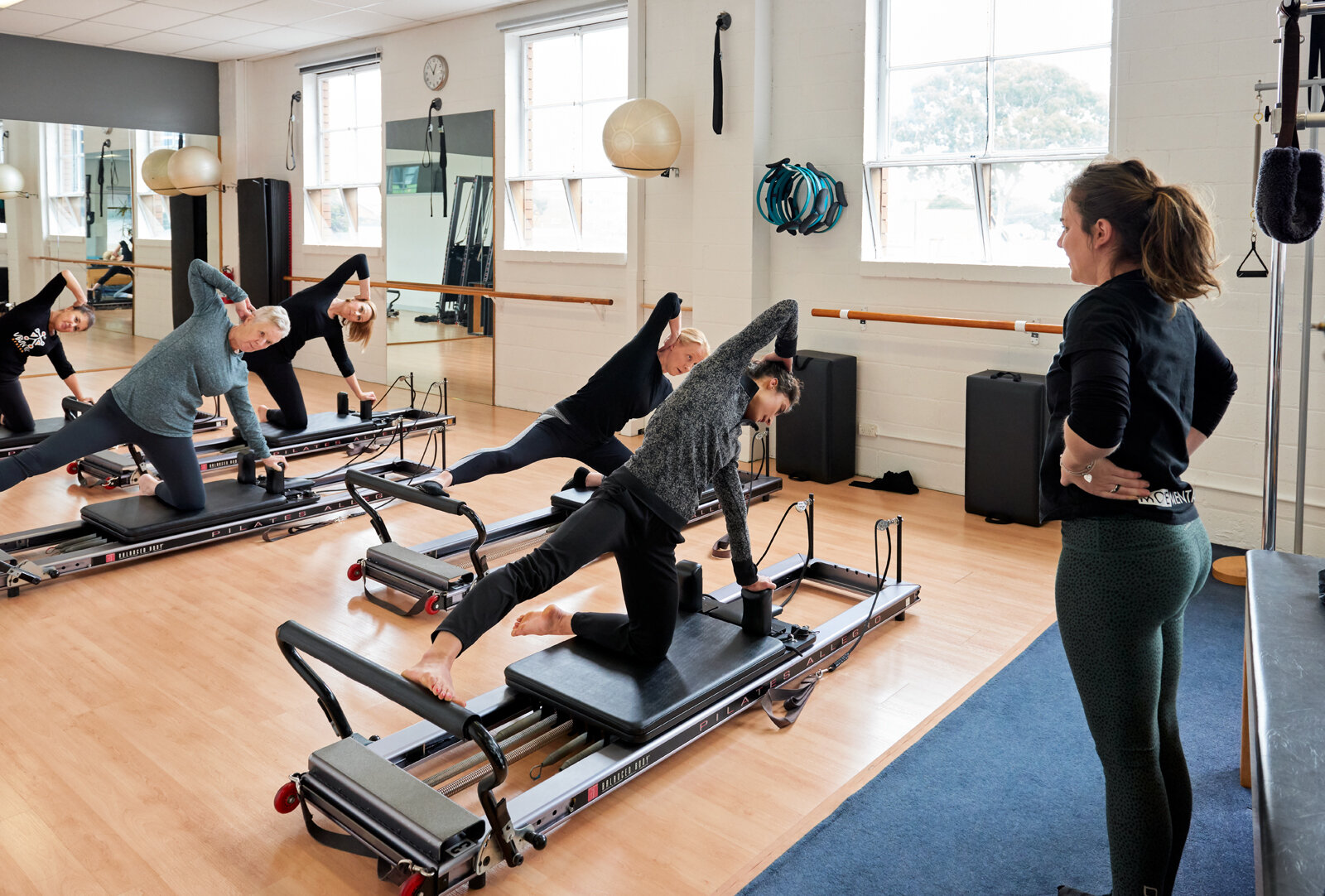
Setting Up A Studio From Scratch
With a combined two decades in the Pilates industry, Ash and Rob believed they understood what it took to run a successful studio. With Rob’s experience managing busy reformer studios in London and Melbourne and Ash’s decade in dance, they seized the opportunity in 2017 to transform the iconic Balance & Control studio in Richmond, Melbourne, Australia into their own venture, Movementality. Their journey was filled with excitement and hard lessons, ultimately leading to a strong brand and a close-knit community.

Transform how you teach
Movement specialist and owner of Movementality in Melbourne, Ashleigh Berry explains to us how we get our clients to move is just as important as what we ask them to do.
Pilates Journal talks to Ashleigh Berry
When was the last time you explained something in detail to a client and they looked more perplexed than before you started explaining? We’ve all been there. In this moment did you make the assumption that they didn’t get it, and that they were missing something? It may sound harsh, but if the client is confused, it’s more likely a reflection on how you’ve demonstrated or explained it, rather than something they’ve done wrong. Perhaps you said too much or overcomplicated the answer. Maybe it’s time to take a breath, revise your approach and try something different.
Pilates Journal asked Ashleigh Berry, movement specialist and owner of Movementality in Melbourne, for her insights into how we make clients move better. Ashleigh understands all too well the nuances involved in working with our clients and how we get our clients to move is just as important as what we ask them to do.

Pilates and the Pelvic Floor Muscles
Having been in the health and fitness industry for over 10 years now, one of the most commons questions I get from a client is either A) what are my pelvic floor muscles, or B) am I meant to be using my pelvic floor muscles now?! And this stems from the fact that about 20 years or so ago, when Pilates was still in its infancy in Melbourne, it became synonymous with physiotherapy in particular, as a support tool for rehabilitating injuries - mainly those of the spine and pelvis. So it got drilled into not only the practitioners, but anyone who did Pilates that they had to squeeze their pelvic floor to do Pilates. In reality, this is far from the case, and has actually become quite problematic for a lot of people, creating dysfunctional pelvic floor muscles, as well as stiff and tight backs.

Pilates for hip pain
People get sore hips, all the time. Every day in the studio is a constant barrage of aches and pain, and without fail 99% of clients will mention something going on in their hips. And fair call - we put them through a lot of work! Between sitting and compressing tissues for hours every day, to then asking them to suddenly go to the other end of the spectrum when running and jumping and generally doing vigorous activity, we don’t really give them the TLC they really deserve. But on the other hand, maybe we need to keep pushing them around to a greater extent? We know the body will always adapt to whatever environment you put it in consistently, so if you want robust hips, maybe you need to ask some robust questions of them?

Pilates for Shoulder Injuries
What most therapists don’t know about rehabilitating shoulders from injury
When it comes to rehabilitating shoulders after injury, Rob has a bit more insight than most. Having been through two almost identical shoulder operations in his late teens (thanks Rugby!) and experiencing two different approaches to rehab, he’s developed some insight in to what all the therapists he’s seen over the year’s always miss. And it’s nothing intention, it’s just that the majority of therapists haven’t experienced shoulder injuries to the extent that they need to start from the beginning again. And if you’re someone who’s reading this and is struggling with shoulder pain, chances are you won’t need all this information - but it’s certainly not going to do you any harm by going right back to basics.

Mindful Practices for Pilates
Firstly, let’s just clear up what mindfulness is - at its most basic, it’s about helping you develop an awareness of yourself and how you feel. That may be a massively oversimplified description, but in reality, that really is all mindfulness needs to be. There are many, many different ways to make this happen, but the ones that get the most attention are those that classically envision a budhist monk sitting on top of a hill, looking over some beautiful scene. And although this probably is a fantastic way to reconnect with yourself, it doesn’t have to be that removed from the modern world. The main goal of becoming aware of yourself and how you feel is actually just to draw your brain back to the present moment, so it’s not burning through energy reserves dwelling on the past and future, and leaves you with a bit more clarity on what’s true for you in that present moment. So let’s discuss some options that you can use for yourself, and develop for use with your clients.

Stress - what it is, and how to work with it
Unfortunately that doesn’t make your job easy in the mean time with clients complaining left, right, and centre, about their aches and pains and perceived stress in their lives. So what can we actually do to help them? Well lets consider one definition of stress is a subjective/relative stimulus driven activation of the sympathetic nervous system, causing a mobilisation of resources towards a fight or flight physiological reaction.

The missing link in your teaching
So you’ve got your Pilates rep down, and feel super confident that at least 4 out of 5 clients that walk through your door are going to get an awesome experience, regardless of what’s going on with them. But there’s still that lingering client that despite all of your amazing hands ons tactile feedback, and beautiful imagery doesn’t seem to get any better. You’re at your wits end, and the client is also getting a bit perplexed and can’t understand why their situation isn’t changing either - frustrating for both parties really!
Here’s a consideration: perhaps their sensory system simply isn’t balanced?

The Power of Group Classes
It seems as though every corner of Melbourne has got a health or fitness studio popping up, offering some form of hyped-up fitness phenomenon. Sweaty bodies, tight active wear, perfect physiques and the golden smile. It’s all part of their pristine marketing campaign to facilitate huge numbers of willing and ambitious people in to their small but busy studios. Why? Perhaps in hopes of achieving the media influenced, socially-accepted ideal body that’s continually pushed down our throats by mainstream marketing. It’s enough to make you reconsider even starting to exercise, and unfortunately Pilates (particularly reformer Pilates) is right in the mix with the best of them…

Three lessons we’ve learnt
We are still working on so much ourselves to make a profitable business that doesn’t wear us down - so don’t stress if you haven’t found that yet, and congrats if you have!. But if you eat the frogs, keep your ego in check, and share the work load then you’ll be on your way to keeping your sanity!

Is Deep Breathing Always the Answer?
Late in 2018 I attended a two day BreatheAbility breathing course with physiotherapist and Breathing Educator Tess Graham. Tess Graham trained with Ukrainian doctor Konstantin Buteyko in the early 1990’s. Buteyko is renowned for his work on breathing retraining for asthmatics and founding the Buteyko Institute. Tess herself has over 6500 hours of clinical experience as a breathing specialist and believes she cured two of her children of their asthma. Naturally, being curious and a Pilates instructor, I was eager to learn about her techniques for breathing retaining which, until now, I hadn’t heard of.

